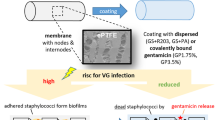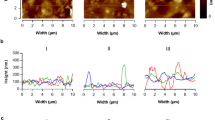Summary
The adherence of staphylococci andEnterobacteriaceae radiolabelled with3H-thymidine to Dacron and polytetrafluoroethylene prosthetic vascular graft materials was investigated using anin vitro method. Adherence readily occurred after a few minutes of incubation.Enterobacteriaceae adhered to Dacron in a 10–100 times greater number per mm of length than to polytetrafluoroethylene. The addition of velour to the Dacron graft further increased the number of adherent bacteria. In contrast, the adherence of coagulase-negative and positive staphylococci per mm of length was roughly the same to Dacron and polytetrafluoroethylene. The adherence of bacteria to vascular graft materials may be part of the underlying pathogenesis of vascular graft infections and differential adherence amongst various graft materials could be of clinical importance. However, in the absence of controlled clinical studies, the significance of these findings remains to be determined.
Zusammenfassung
Die Adhärenz von3H-Thymidin markierten Staphylokokken undEnterobacteriaceae an prothetischen Gefäßimplantaten aus Dacron und Polytetrafluoräthylen wurde mit einerIn-vitro-Methode untersucht. Es kam prompt nach einer Inkubationszeit von wenigen Minuten zur Adhärenz.Enterobacteriaceae hafteten in zehn bis hundertfach größerer Zahl pro mm Länge an Dacron als an Polytetrafluoräthylen. Wenn die Dacron-Prothese darüber hinaus noch mit Velour versehen wurde, vermehrte sich die Zahl der adhärenten Bakterien noch weiter. Die Adhärenz von Koagulase-negativen und -positiven Staphylokokken pro mm Länge war hingegen bei Dacron und Polytetrafluoräthylen annähernd gleich groß. Die Adhärenz von Bakterien an Gefäßprothesenmaterial dürfte ein pathologisch bedeutsamer Faktor für die Protheseninfektion sein, und die Differenz in der Adhärenz bei verschiedenen Prothesenmaterialien könnte klinische Relevanz haben. Jedoch ist es Aufgabe kontrollierter klinischer Studien, die Bedeutung dieser Befunde zu definieren.
Similar content being viewed by others
Literature
Fowler, J. E., Jr., Stamey, T. A. Studies of introital colonization in women with recurrent urinary infections. VII. The role of bacterial adherence. J. Urol. 117 (1977) 472–476.
Gibbons, R. J., van Houte, J. Bacterial adherence in oral microbial ecology. Ann. Rev. Microbiol. 29 (1975) 19–44.
Gould, K., Ramirez-Ronda, C. H., Holmes, R. K., Sanford, J. P. Adherence of bacteria to heart valvesin vitro. J. Clin. Invest. 56 (1975) 1364–1370.
Svanborg-Eden, C., Jodal, U., Hanson, L. A., Lindberg, U., Akerlund, A. S. Variable adherence to normal human urinarytract epithelial cells ofEscherichia coli strains associated with various forms of urinary tract infections. Lancet II (1976) 490–495.
Ulshen, M. H., Rollo, J. L. Pathogenesis ofEscherichia coli gastroenteritis in man — another mechanism. N. Engl. J. Med. 302 (1980) 99–101.
Clark, W. B., Bammann, L. L., Gibbons, R. J. Ability ofStreptococcus mutans and a glycosyltransferase-defective mutant to colonize rodents and attach to hydroxyapatite surfaces. Infect. Immun. 21 (1978) 681–684.
Tinanoff, N., Tanzer, J. M., Freedman, M. L. In vitro colonization ofStreptococcus mutans on enamel. Infect. Immun. 21 (1978) 1010–1019.
Wheeler, T. T., Clark, W. B. Fibril-mediated adherence ofActinomyces viscosus to saliva-treated hydroxyapatite. Infect. Immun. 28 (1980) 577–584.
Goldstone, J., Moore, W. S. Infection in vascular prostheses. Clinical manifestations and surgical management. Am. J. Surg. 128 (1974) 225–233.
Moore, W. S. Infection in prosthetic vascular grafts: In:Rutherford, R. B. (ed.): Vascular Surgery. W. B. Saunders Co., Philadelphia 1977, pp. 385–396.
Szilagyi, D. E., Smith, R. F., Elliott, J. P., Vrandecic, M. P. Infection in arterial reconstruction with synthetic grafts. Ann. Surg. 176 (1972) 321–333.
Bayston, R., Penny, S. R. Excessive production of mucoid substance in staphylococcus SIIA: a possible factor in colonisation of Holter shunts. Dev. Med. Child. Neurol. 14 Suppl. 27 (1972) 25–28.
Holt, R. The early serological detection of colonisation byStaphylococcus epidermidis of ventriculo-atrial shunts. Infection 8 (1980) 8–12.
Sugarman, B., Donta, S. T. Attachment ofEnterobacteriaceae to human buccal cells. J. Med. Microbiol. 12 (1979) 373–378.
Fader, R. C., Davis, C. P. Effect of piliation onKlebsiella pneumoniae infection in rat bladders. Infect. Immunol. 30 (1980) 554–561.
Isaacson, R. E., Fusco, P. C., Brinton, C. C., Moon, H. W. In vitro adhesion ofEscherichia coli to porcine small intestinal epithelial cells: pili as adhesive factors. Infect. Immunol. 21 (1978) 392–397.
Woods, D. E., Straus, D. C., Johanson, W. G., Jr., Berry, V. K., Bass, J. A. Role of pili in adherence ofPseudomonas aeruginosa to mammalian buccal epithelial cells. Infect. Immunol. 29 (1980) 1146–1151.
Aly, R., Shinefield, H. R., Litz, C., Maibach, H. I. Role of teichoic acid in the binding ofStaphylococcus aureus to nasal epithelial cells. J. Infect. Dis. 141 (1980) 463–465.
Malone, J. M., Moore, W. S., Campagna, G., Bean, B. Bacteremic infectability of vascular grafts: the influence of pseudointimal integrity and duration of graft function. Surgery 78 (1975) 211–216.
Moore, W. S., Malone, J. M., Keown, K. Prosthetic arterial graft material. Influence on neointimal healing and bacteremic infectibility. Arch. Surg. 115 (1980) 1379–1383.
Roon, A. J., Malone, J. M., Moore, W. S., Bean, B., Campagna, G. Bacteremic infectability: a function of vascular graft material and design. J. Surg. Res. 22 (1977) 489–498.
Simpson, W. A., Ofek, I., Beachey, E. H. Fatty acid binding sites of serum albumin as membrane receptor analogs for streptococcal lipoteichoic acid. Infect. Immunol. 29 (1980) 119–122.
Sugarman, B. Attachment of bacteria to mammalian surfaces. Infection 8 (1980) 132–141.
Author information
Authors and Affiliations
Rights and permissions
About this article
Cite this article
Sugarman, B. In vitro adherence of bacteria to prosthetic vascular grafts. Infection 10, 9–12 (1982). https://doi.org/10.1007/BF01640828
Received:
Issue Date:
DOI: https://doi.org/10.1007/BF01640828




